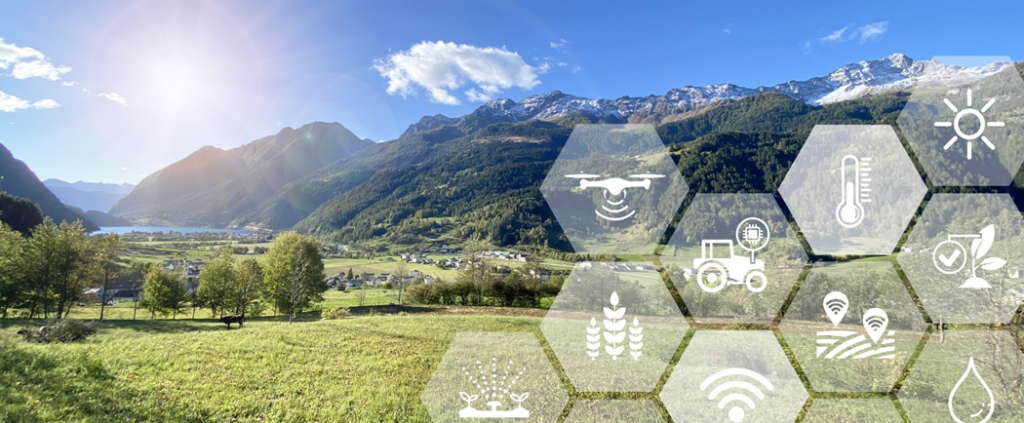Ein Beitrag von Doriano Hautle

Digital technology can be employed at different stages of a food system, improving efficiency, sustainability, and increasing transparency in the value chain. In the future, robotic vehicles and drones fitted with hyperspectral cameras will be able to collect data about plants and livestock, preparing the grounds for sophisticated, evidence based farm management.
Opportunities of smart farming
When associated with farming, “smart” usually refers to new digital technologies. For example, autonomously operating sensors and machines that scan the fields, recording images and data subsequently used to assess the status of the plants, detecting illnesses. GPS sensors fitted on cattle can track movements and intelligent software unveil behavioral patterns, allowing for better care of the animals. Farmers could profit from the knowledge of other farmers by sharing experiences on a common digital platform. Overall, digitized data allows easier tracking of the production process of goods, increasing transparency in the value chain.1,2,3
Challenges in mountainous areas
Mountainous areas are disadvantaged for agriculture because of steep terrain and increased soil erosion. Digital farming technologies rely on area-wide internet coverage, which despite the fast expansion of the 5G network is still hardly available in remote areas.4 Moreover, since new technologies are mostly applied to widely grown crops, applications to less popular crops – as found in small mountain farms – are unexplored. Despite the challenges and in virtue of the importance of mountain farming for the preservation of alpine landscapes, public fundings aim to bring smart technologies to these areas.5
The farmers’ attitude towards new technology
According to a study performed in the Italian Valtellina, a rural valley extending between 200 and 4000 m asl, only one in four farmers adopts information and communication technology to agriculture.6 Despite no general aversion towards modern technologies, farmers perceive many obstacles like costs, time demand, the lack of clear benefits, lower precision, and distancing from the care of animals and plants. Perceived pro-arguments are easier monitoring of production parameters, better breeding management and the fulfillment of regulations. Farmers who are older, with lower education, lower smartphone usage and a more pessimistic attitude towards the future, have a lower acceptance for technology.6
Valposchiavo: a “hypermap” to improve sustainability
In the Swiss Valposchiavo, a valley situated next to Valtellina, the project “Smart Valley Bio” involves a “hypermap” which allows experts and laypeople to map their knowledge and ideals of the landscape. The goal is to connect local stakeholders and assist decision making with a centralized knowledge repository, by visualizing and communicating the values of the landscape. During my visit to the forum “Origin, Diversity and Territories” in Poschiavo in October 2021, Cassiano Luminati 8, strategical coordinator of the project, argues that “it’s a tool for us here in the area to understand better what is going on, because not everybody is really aware”. He adds that by “aggerating this kind of data you can create narrations”, creating an added value for local products. The project has received fundings from the ARE.9
A future with many possibilities
Digital technologies can be applied to the entire food chain of mountainous areas. The Valtellina study and the Valposchiavo example show that a bottom-up approach is most appropriate. When farmers participate to the development of the technologies, they get more familiar with it and application is easier. To involve older farmers, innovative forms of presentation and teaching of smart farming practices are required. Participatory approaches are a good way to collect knowledge and have great potential to increase the sustainability of food systems.
Dieser Blog-Beitrag entstand im Rahmen des Mastermoduls «Agroecology and Food Systems» des Studiengang Umwelt und Natürliche Ressourcen am Institut für Umwelt und Natürliche Ressourcen der ZHAW im Herbstsemester 2021.
Quellen
1 Walter, A., Finger, R., Huber, R. and Buchmann, N. (2017): Smart farming is key to developing sustainable agriculture. Proceedings of the National Academy of Sciences of the United States of America, Vol. 114(24), pp. 6148–6150.
2 Adelabu, D. B., Clark, V. R. and Bredenhand, E. (2020): Potential for sustainable mountain farming: Challenges and prospects for sustainable smallholder farming in the maloti-drakensberg mountains. Mountain Research and Development, Vol. 40(1), pp. A1–A11.
3 Federal Department of Foreign Affairs FDFA (2019): Agriculture 4.0 – the Swiss Smart-Farming Revolution. House of Switzerland. URL: <https://houseofswitzerland.org/swissstories/economics/agriculture-40-swiss-smart-farming-revolution> (Accessed: 27.20.2021).
4 Sunrise Communications (2021): Sustainable agriculture is digital. URL: <https://www.sunrise.ch/business/en/enterprise/industries/smart-farming> (Accessed: 27.20.2021).
5 Blunier, R. (2021): Nationalrat will Alpwirtschaft mit Smart Farming helfen. Schweizer Bauer. URL: <https://www.schweizerbauer.ch/politik-wirtschaft/agrarpolitik/nationalrat-will-alpwirtschaft-mit-smart-farming-helfen/> (Accessed: 27.20.2021).
6 Marescotti, M. E., Demartini, E., Filippini, R. and Gaviglio, A. (2021): Smart farming in mountain areas: Investigating livestock farmers’ technophobia and technophilia and their perception of innovation. Journal of Rural Studies. Elsevier Ltd, Vol. 86, pp. 463–472.
7 Ufficio federale dello sviluppo territoriale ARE (2020): Valposchiavo (GR): salvaguardare nel tempo i valori paesaggistici per le generazioni future. URL: <https://www.are.admin.ch/are/it/home/sviluppo-e-pianificazione-del-territorio/programmi-e-progetti/progetti-modello-sviluppo-sostenibile-del-territorio/modellvorhaben/dare-maggiore-valenza-al-paesaggio/valposchiavo-gr-salvaguardare-nel-tempo-i-valori-paesaggistici-per-le-generazioni-future.html> (Accessed: 27.20.2021).
8 Celio, E., Cabassi Bombardieri, R. and Luminati, C. (14.10.2021): Workshop with communication agency dpstudio. Forum Origin, Diversity and Territories, Poschiavo, Switzerland.
9 Pettenati, G. (2021): The re-naturalization of food in Valposchiavo: Political ecology of an ‘organic valley’. Rivista Geografica Italiana, (2), pp. 137–153.

You’ve made some good points there. I am glad that you just shared this helpful information with us. Thank you for sharing.
Hyperspectral Imagery and Space Data Company